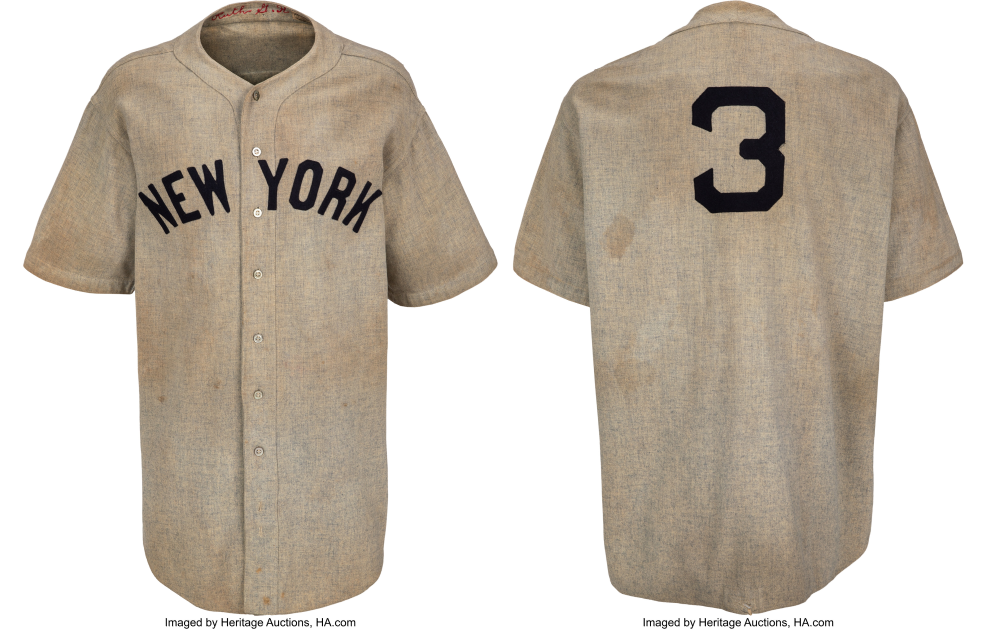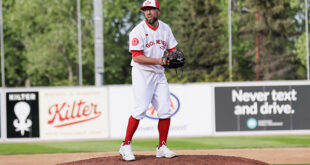Babe Ruth’s fifth-inning home run against the Chicago Cubs during Game 3 of the 1932 World Series “has been argued about and debunked and reconsidered and investigated for almost a century,” Joe Posnanski wrote in 2023’s bestselling Why We Love Baseball. The Called Shot, as it’s been known ever since Babe’s swing met Cubs pitcher Charlie Root’s pitch that first day of October in Chicago — three little words about which endless stories have been told ever since.
To that legend, Heritage Auctions proudly offers another chapter: The New York Yankees road gray jersey Ruth wore that brilliantly bright Saturday in Chicago will be a centerpiece of the Summer Platinum Night Sports Auction from Aug. 23-25. The jersey, bearing Ruth’s No. 3, has been photomatched to Game 3 of the 1932 World Series.
The jersey is twice authenticated, including by MeiGray Authenticated, which says the jersey was matched using two photos from Getty Images and a third from The Chicago Daily News showing Ruth, Lou Gehrig and manager Joe McCarthy in the dugout. Ruth gifted the jersey to a Florida man following a round of golf, where it remained until the man’s daughter auctioned it nearly two decades ago. It has only recently been photomatched.
“Ruth’s World Series jersey is the most significant piece of American sports memorabilia to be offered at auction in decades,” says Chris Ivy, Director of Sports Auctions at Heritage. “Given its history, its mythology, we expect that when the final bid is placed, it will hold the record as the most expensive sports collectible ever to cross the auction block.”
For now, at least, that record belongs to another Yankees legend, Mickey Mantle, whose 1952 Topps card graded Mint+ 9.5 by Sportscard Guaranty Corporation sold for $12.6 million at Heritage in August 2022.
History doesn’t often talk about the fact Ruth hit two home runs in that World Series skirmish, the first coming in the initial frame after Ruth, with a two-ball count, taunted Cubs pitcher Charlie Root by demanding he throw him strikes. Cubs fans and players were already giving Ruth hell as lemons flew from the stands and insults streamed from the dugout. Ruth homered to right center with the next pitch.
“The boos for Ruth as he rounded the bases were loud and even ominous,” Posnanski writes. “Ruth luxuriated in them. That’s not the Called Shot. Not yet.”
That moment in the fifth inning when Ruth gestured toward something or someone — perhaps the Chicago Cubs’ dugout or pitcher Charlie Root or the center field flagpole — has been endlessly celebrated, imitated and replicated over the last 92 years. That home run, which came on a two-strike count, has been depicted in paintings, exaggerated in movies and parroted by anyone who’s ever played beer-league ball on a rec-league field. Those three little words, The Called Shot, will live so long as there’s someone left to tell stories about the day Ruth smashed a baseball farther than anyone had ever before hit a baseball at Wrigley Field.
As Posnanski points out, Ruth had called a few shots before, including once as a promise to a young man in a hospital and once as a response to jeering Cubs fans in the 1918 World Series, when Ruth was still throwing baseballs for Boston. The man hit 714 home runs during his 22 seasons in the sun. Most would inevitably wind up as footnotes in a historic career. Some have great stories. But only one is the final World Series home run of his career and the stuff of which myth was made.
Some significant witnesses were sitting in the Wrigley Field stands on Oct. 1, 1932, among them Franklin Delano Roosevelt, the New York governor days away from winning the White House, and future Supreme Court Justice John Paul Stevens, then just a boy of 12. But they were just spectators. Others would step forward over the coming days and decades to tell a story that grew into the stuff of folklore.
By all accounts, it took but a few hours before a journalist began crafting the myth. Joe Williams, then a sports editor for Scripps-Howard, recapped the moment for the evening papers: “In the fifth,” he wrote, “with the Cubs riding him unmercifully from the bench, Ruth pointed to center field and punched a screaming liner to a spot where no ball had been hit before.” As the National Baseball Hall of Fame notes, Williams added to his wire story a headline invoking a billiards reference: “Ruth Calls Shot As He Puts Home Run No. 2 In Side Pocket,” which is how the story appeared in the New York World-Telegram.
 Sports Media Report
Sports Media Report

